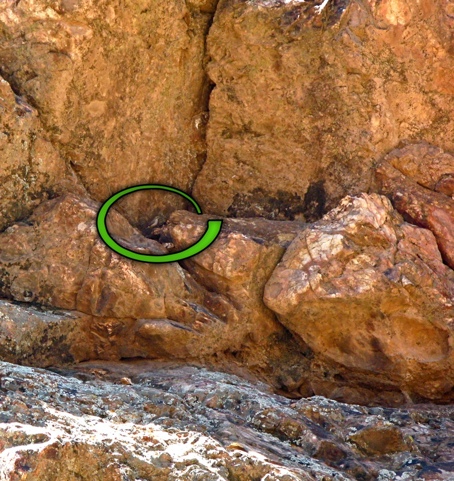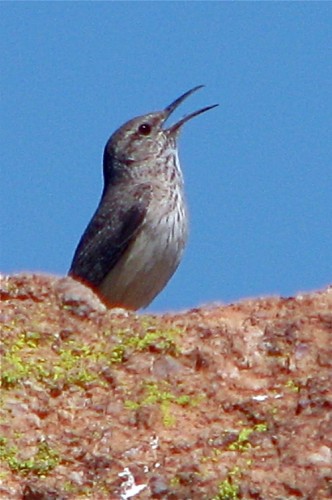Spot the Bird answer: rock and wren
 To the right is the photo key to the Rock wren of the current Spot the Bird. Rock wrens rock one of my favorite Latin names in the bird world (along with Upupa epops, the hoopoe): Salpinctes obsoletus. According to Choate, the name comes from Greek salpinctes, “a trumpeter” and Latin obsoletus, “indistinct”, referring to its ringing voice and drab plumage. These contradictory traits explain why the little bird is often heard before it’s seen. Some of you who wrote to tell me you found it said that after not seeing it for a while “it just suddenly popped out of the picture”. That’s the way it tends to happen in person with these guys, too.
To the right is the photo key to the Rock wren of the current Spot the Bird. Rock wrens rock one of my favorite Latin names in the bird world (along with Upupa epops, the hoopoe): Salpinctes obsoletus. According to Choate, the name comes from Greek salpinctes, “a trumpeter” and Latin obsoletus, “indistinct”, referring to its ringing voice and drab plumage. These contradictory traits explain why the little bird is often heard before it’s seen. Some of you who wrote to tell me you found it said that after not seeing it for a while “it just suddenly popped out of the picture”. That’s the way it tends to happen in person with these guys, too.
Below is a rock wren up close, singing its song. You can see its long, de-curved bill, useful for probing rocks and crevices for insects and spiders. It’s also good for carrying and manipulating small rocks: Rock wrens  construct a pavement of tiny flat stones and pebbles leading up to their nest, which is concealed in a hole or crack in a rock. No one (except the wrens) knows why they do this. (<< photo E.Shock, taken at Fremont Saddle in the Superstition mountains) One thing the beak does not do is take up water: Rock wrens are thought to get all their moisture through their prey, and don’t drink even when water is available.
construct a pavement of tiny flat stones and pebbles leading up to their nest, which is concealed in a hole or crack in a rock. No one (except the wrens) knows why they do this. (<< photo E.Shock, taken at Fremont Saddle in the Superstition mountains) One thing the beak does not do is take up water: Rock wrens are thought to get all their moisture through their prey, and don’t drink even when water is available.
Speaking of water, E would like me to add that the rocks in the top photo, along Castle Hotsprings Road, are significantly hydrothermally altered. You know, subjected to intense heat in a moist environment, either at depth, or nearer the surface, as in a hotspring. I don’t suppose the rock wren cares, except that the hydrothermal process has left the rock cracked and full of holes, which is just what a rock wren likes. Click here for a tale about another hydrothermally-altered rock that hosted many organisms.
